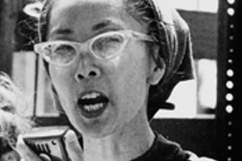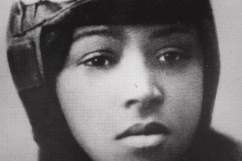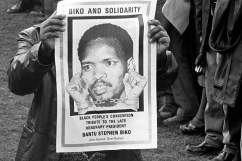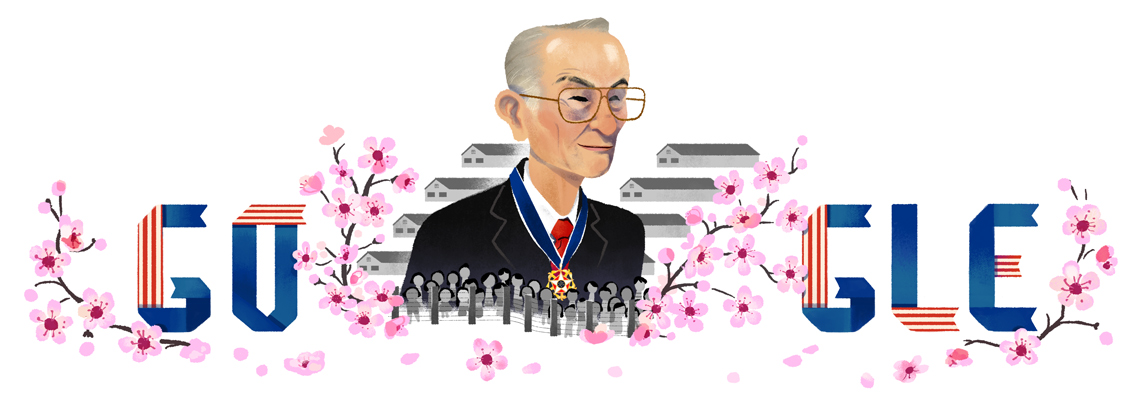
(Google/Sophie Diao)
Civil rights icon Fred Korematsu , who was among Japanese-Americans held in internment camps during World War II, is being celebrated with a Google Doodle on what would have been his 98th birthday.
Korematsu battled against the internment order, standing up for thousands of fellow Japanese-Americans.
“Fred Korematsu can be remembered fighting for civil rights and against prejudice throughout his life,” Google says. “The doodle by artist Sophie Diao–herself a child of Asian immigrants–features a patriotic portrait of Korematsu wearing his Presidential Medal of Freedom, a scene of the internment camps to his back, surrounded by cherry blossoms, flowers that have come to be symbols of peace and friendship between the US and Japan.”
Not long before his death in 2005, Korematsu, spoke out about how some have used Japanese internment as a justification for profiling against Muslims in the fight against terrorism:
Fears and prejudices directed against minority communities are too easy to evoke and exaggerate, often to serve the political agendas of those who promote those fears. I know what it is like to be at the other end of such scapegoating and how difficult it is to clear one’s name after unjustified suspicions are endorsed as fact by the government.
If someone is a spy or terrorist they should be prosecuted for their actions. But no one should ever be locked away simply because they share the same race, ethnicity, or religion as a spy or terrorist. If that principle was not learned from the internment of Japanese Americans, then these are very dangerous times for our democracy.
“If you have the feeling that something is wrong, don’t be afraid to speak up,” he famously said.
Here’s what you need to know about Korematsu:
1. Korematsu Was Born in Oakland & Was Not Able to Find a Job After High School Because He Was of Japanese Descent
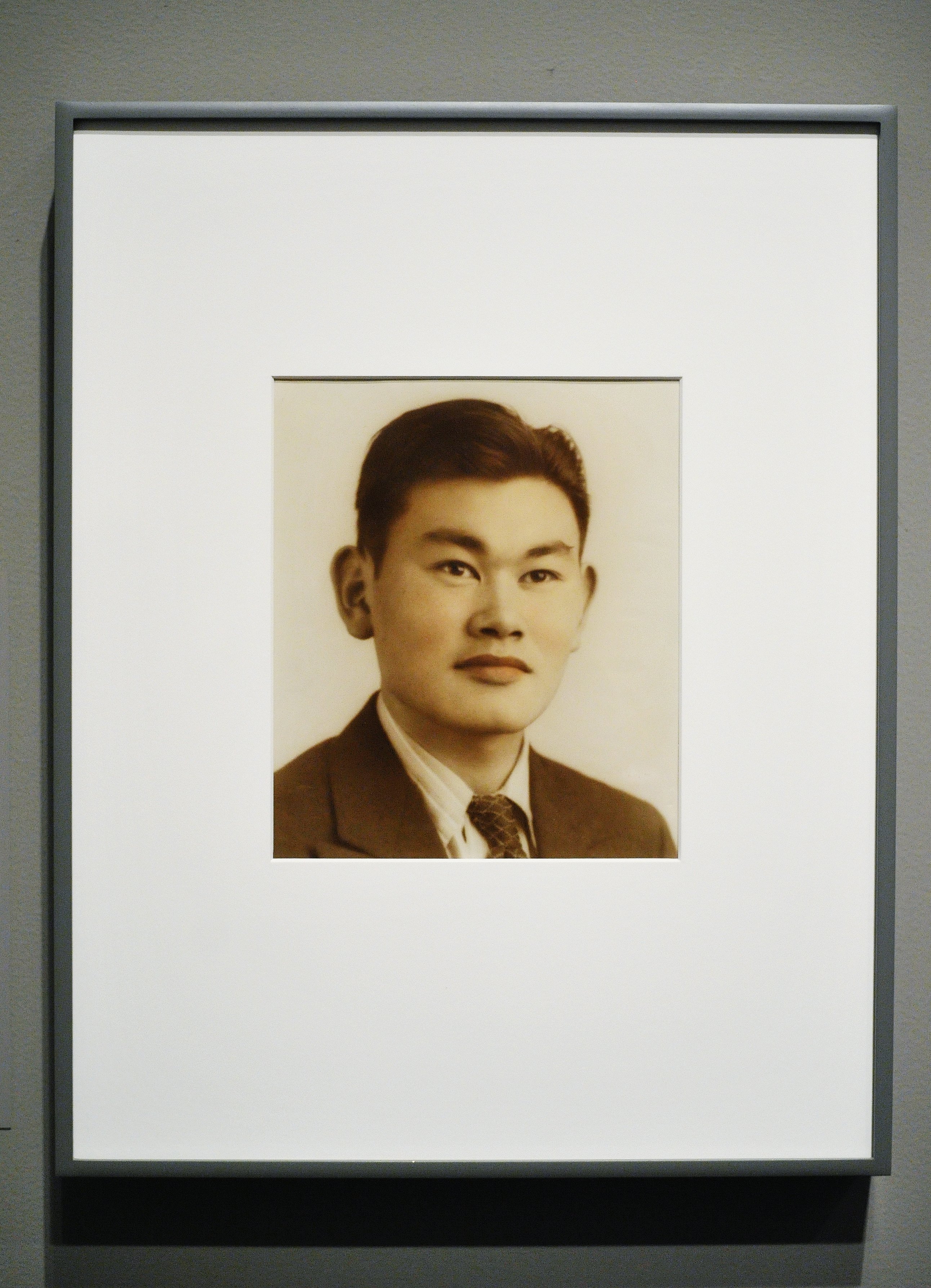
The portrait of Fred Korematsu is seen during its presentation to the National Portrait Gallery on February 2, 2012 in Washington, DC. The 1940s era photograph becomes part of the museum’s permanent collection. (Getty)
Toyosaburo “Fred” Korematsu was born January 30, 1919, in Oakland, California, to Kotsui Aoki and Kakusaburo Korematsu, who had immigrated to the United States in 1905, according to his biography on the Korematsu Institute’s website. They ran a floral nursery in Oakand.
He had three brothers. Korematsu attended Castlemont High School in Oakland, where he played tennis and was on the swim team.
Korematsu tried to enlist in the military in 1940, but was rejected due to stomach ulcers. He then tried to work at a shipyard and elsewhere to help the war effort, but was fired because he was Japanese.
He “trained to become a welder, eventually working at the docks in Oakland as a shipyard welder and quickly rising through the ranks to foreman,” the Korematsu Institute says. “One day, when he arrived to punch in his time card, Korematsu found a notice to report to the union office, where he was suddenly fired from his job due to his Japanese ancestry.”
After the attack on Pearl Harbor, he was unable to obtain a job anywhere.
2. He Was Arrested in 1942 for Trying to Dodge Internment, Leading to a Landmark Supreme Court Case, Korematsu vs. the United States
After the Pearl Harbor attack, Korematsu underwent plastic surgery on his eyes to disguise his Asian features and changed his name on his draft registration card to Clyde Sarah, the New York Times said in his obituary. He also listed his background on the card as Spanish-American.
He had an Italian girlfriend at the time and hoped the changes would allow him to avoid racism and internment.
Korematsu was arrested in 1942 after going into hiding rather than surrendering to an internment camp. He was recognized as being Japanese on a San Francisco street corner and taken to jail.
After he was arrested, the American Civil Liberties Union’s director in northern California approached him about using his case to test the legality of the internment order, which impacted about 120,000 Japanese-Americans.
“I was stunned, I couldn’t believe this was happening in America,” Korematsu said in an article on the ACLU’s website. “I was surprised when the guard came and told me I had a visitor. I didn’t know him, but he introduced himself as Mr. Ernest Besig of the American Civil Liberties Union.”
The ACLU provided him with a lawyer, be was convicted of violating a federal order and sentenced to five years of probation.
His conviction was appealed by the ACLU and eventually held up in the landmark U.S. Supreme Court case, Korematsu vs. the United States. The ACLU argued the “exclusion and detention laws violated basic constitutional rights,” but lost, with the war-time measure being declared constitutional.
The court ruled 6-3, according to PBS.
Justice Hugo Black wrote in the majority opinion that while “all legal restrictions which curtail the civil rights of a single racial group are immediately suspect” and deserve “the most rigid scrutiny,” they are not all unconstitutional.
He said, “Pressing public necessity may sometimes justify the existence of such restrictions; racial antagonism never can.”
The six justices in the majority sided with the military’s argument that some Japanese-Americans were not loyal to the United States, but were instead loyal to their ancestral country. The court agreed that separating “the disloyal from the loyal” was impossible logistically, so the internment order had to apply to all Japanese Americans within the restricted area.
The court ruled the security concerns of the nation outweigh the equal rights promised by the Constitution.
In his dissent, Justice Robert Jackson said Korematsu, “has been convicted of an act not commonly thought a crime. It consists merely of being present in the state whereof he is a citizen, near the place where he was born, and where all his life he has lived.”
Korematsu and his family were held at the Central Utah War Relocation Center in Topaz, Utah, until the end of World War II in 1945.
“I felt I knew I was an American citizen, but with everyone against you, the government against you and no one to help you, I figured it was just a slim chance,” Korematsu told filmmaker Steven Okazaki in 1983. “But I was going to see what I could do and see what happens.”
3. His Conviction Was Overturned in 1983 & He Was Awarded the Presidential Medal of Freedom in 1998

President Bill Clinton stands with Fred Korematsu after awarding him the Presidential Medal of Freedom, the nation’s highest civilian honor, January 15 during ceremonies at the White House in Washington, DC. (Getty)
In 1976, President Gerald Ford ended Executive Order 9066, which allowed for the internment of Korematsu and other Japanese-Americans, and said, “We now know what we should have known then — not only was that evacuation wrong but Japanese-Americans were and are loyal Americans.”
His conviction was eventually overturned in 1983 and he was finally vindicated, according to PBS.
The Civil Liberties Act of 1988 included a formal apology to Korematsu and the others held in internment camps.
A Congressional report found the Supreme Court ruling in Korematsu vs. the United States had been “overruled in the court of history.”
But the ruling was never overturned, and still does stand, and some in recent years have feared it could be used against Muslims. The Atlantic’s Matt Ford discussed the issue in November 2016 after President Donald Trump’s election, pointing to the dissent that stated the case “legalized racism.”
In one of its most widely condemned decisions, the U.S. Supreme Court upheld the exclusion orders in Korematsu v. United States. Justice Hugo Black argued for a 6-3 majority that the exclusion orders were a necessary outgrowth of the president’s war powers and justified by the situation at hand. ‘Compulsory exclusion of large groups of citizens from their homes, except under circumstances of direst emergency and peril, is inconsistent with our basic governmental institutions,’ he wrote in his opinion for the Court. ‘But when, under conditions of modern warfare, our shores are threatened by hostile forces, the power to protect must be commensurate with the threatened danger.’
The Supreme Court has never overturned Korematsu, largely because federal and state governments have not attempted the mass internment of an entire ethnic group since then. But the decision belongs to what legal scholars describe as the anti-canon of American constitutional law — a small group of Supreme Court rulings universally assailed as wrong, immoral, and unconstitutional. Dred Scott v. Sandford, Plessy v. Ferguson, Buck v. Bell, and Korematsu form the anti-canon’s core; legal scholars sometimes include other decisions as well.
Korematsu went on to have an even larger impact through his civil rights activism.
In 1998, Korematsu was awarded the nation’s highest civilian honor, the Presidential Medal of Freedom, by President Bill Clinton.
“In the long history of our country’s constant search for justice, some names of ordinary citizens stand for millions of souls. Plessy, Brown, Parks,” Clinton said. “To that distinguished list, today we add the name of Fred Korematsu.”
4. Korematsu, Who Died in 2005, Was Married & Had 2 Children
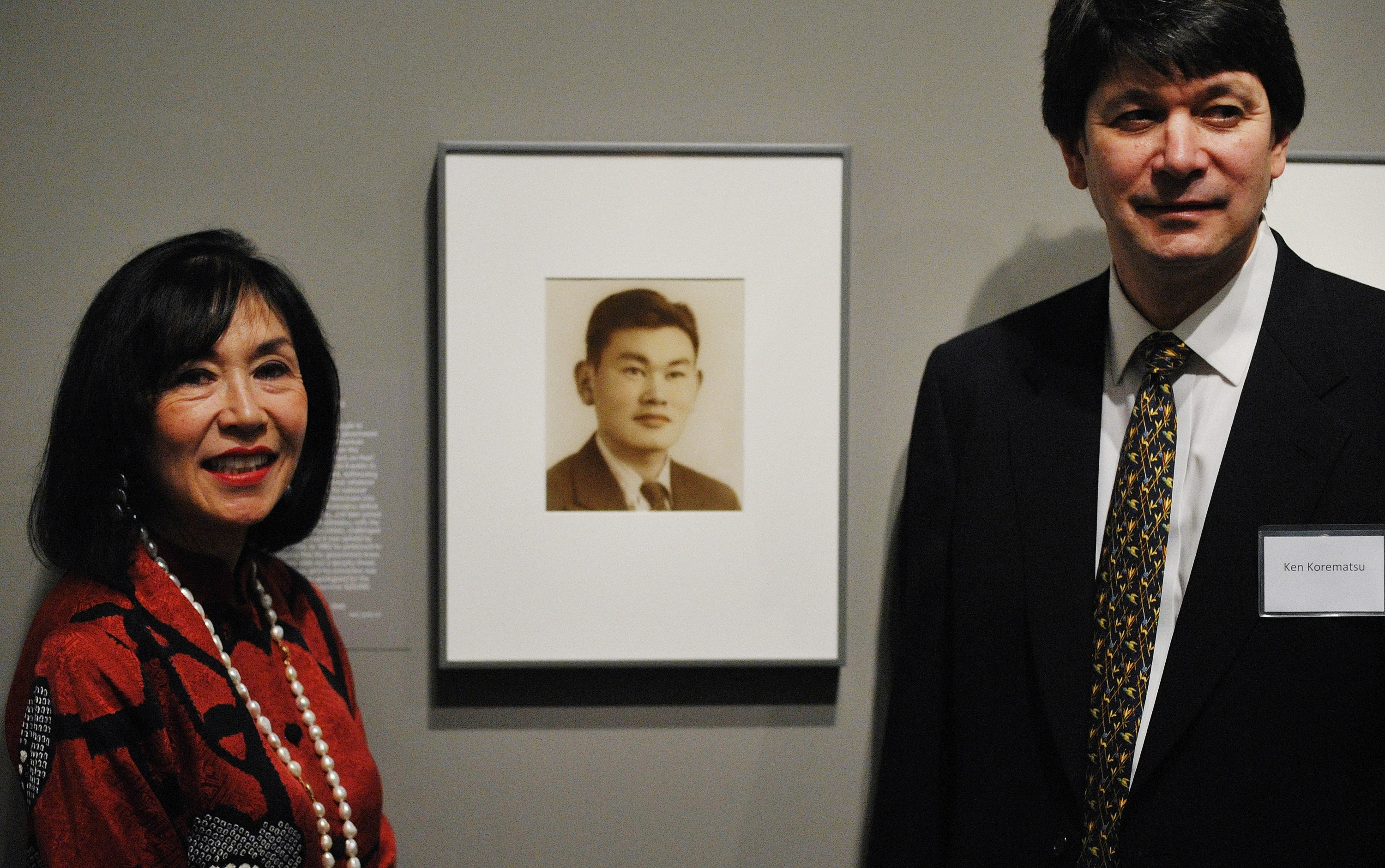
Karen and Ken Korematsu pose near photographs of their father Fred Korematsu during a presentation of his portrait to the National Portrait Gallery on February 2, 2012 in Washington, DC. (Getty)
Korematsu died of respiratory illness at the age of 86 in California on March 30, 2005,, according to the Los Angeles Times.
He was survived by his wife of 59 years, Kathryn Pearson Korematsu, along with two children, Karen and Ken.
“He had a very strong will,” his attorney, Dale Minami told the LA Times. “He was like our Rosa Parks. He took an unpopular stand at a critical point in our history.”
Korematsu lived in Oakland for most of his life, except for some time spent in Detroit, Michigan, after his internment. It was there that he met his future wife, who was a student at Wayne State University, according to the Korematsu Institute.
He struggled with his label as a criminal for most of his life, until his conviction was overturned in 1983.
It had a “lasting impact on his basic rights, affecting his ability to obtain employment,” according to the Korematsu Institute.
He fought for reparations and for the U.S. government to admit its wrongdoing.
“I would like to see the government admit that they were wrong and do something about it so this will never happen again to any American citizen of any race, creed, or color,” he told U.S. District Judge Marilyn Patel when his conviction was overturned.
Korematsu continued to fight for civil liberties late in life, trying to prevent Muslims in America from being discriminated against like he and Japanese-Americans had been.
He filed amicus briefs in two post-9/11 cases related to Guantanamo Bay, one in 2003 and one in 2004, warning the government not to repeat the mistakes of Japanese internment.
According to Densho, Korematsu said right before his death, “I’ll never forget my government treating me like this. And I really hope that this will never happen to anybody else because of the way they look, if they look like the enemy of our country,” urging people to “protest, but not with violence, and don’t be afraid to speak up. One person can make a difference, even if it takes forty years.”
5. Fred Korematsu Day Is Celebrated on His Birthday in California & 3 Other States
Korematsu’s legacy is carried on by the Fred T. Korematsu Institute, which works with teachers and community leaders across the country to promote his fight for justice and civil liberties.
And, Fred Korematsu Day is celebrated in his native state of California on his birthday each year. The day of celebration began in 2010. It is also celebrated in Hawaii, Florida and Virginia.
This year’s Fred Korematsu Day falls during a relevant time for Americans, as people have taken to the streets to protest President Donald Trump’s executive order banning refugees and visa-holders from seven Muslim-majority countries out of fears they could carry out terror attacks in the name of radical Islam in this country.
Protesters flocked to airports around the country and the ACLU, which fought for Korematsu, has promised a legal challenge to the travel ban. Attorneys have already won temporary battles to allow for some of the barred travelers who were detained in U.S. airports to stay in the country while the Constitutionality of Trump’s order is heard.
In 2015, at a ceremony on Korematsu Day, NBC Asian America’s Frances Kai-Hwa Wang spoke about the similarities between Korematsu’s fight and the one facing Muslims in America today:
Fred Korematsu was not much older than you when he resisted the order to be interned at 23. At the time, he says he just wanted to live his life, but then he also realized that it was important to fight for what is right. Other second-generation or Nisei Japanese American men age 18 and up, also not much older than you, volunteered for the US military, the celebrated 442nd Regimental Combat Team and 100th Infantry Battalion—the two most decorated military units in US history—in order to prove their loyalty and the loyalty of their families to the United States. Unfortunately, some of the racist fears behind the incarceration of Japanese Americans during World War II still exist in our society, in our state, in our schools, and it is important for all of us to take the time to get to know each other better, to stand up for each other, and to speak out when we see prejudice and injustice. This is for all of us. As Fred Korematsu said, ‘If you have the feeling that something is wrong, don’t be afraid to speak up.’ and ‘Stand up for what is right.’
Korematsu’s daughter, Karen, who is the director of the institute that bears her father’s name, also recently spoke out about her father’s legacy as it pertains to Muslim-Americans today.
“He would be really disgusted that we haven’t learned our lessons of history,” she said of Trump in an interview with KTVU-TV. “What we didn’t learn from 1942 from President Roosevelt’s executive order is that we cannot racially profile and assume that everyone is guilty just because they are associated with one religion or one ethnic group.
“It’s very scary. It’s like 1942 all over again,” she said. “So when people are making statements that totally go against all principles of being an American, then we all need to speak up.”
Of executive orders, like the immigration order issued by Trump and the one issued by President Franklin D. Roosevelt that led to her father’s internment, she said Americans might not understand their power.
“That does not need to be approved by Congress. That’s the power of the executive order,” she told KQED-TV. “So we need to caution people and make them aware that we are in danger of making the same mistakes.”
Karen Korematsu told the San Francisco Chronicle she is hopeful people speak up against discriminatory orders.
“Fortunately, now we have other organizations that are able to speak up, whereas in 1942 there really wasn’t anyone,” she said. “But now that’s all changed, and we should all work together so that we can change the hearts and minds and stop this racial profiling and this racial discrimination in this country.”

